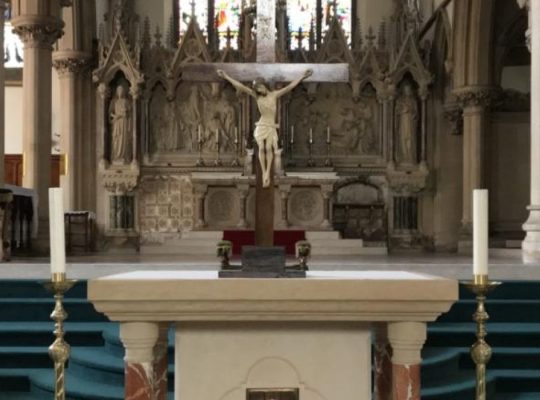The procession with branches celebrates, in its multiple aspects, the triumph of Christ the King, and the Mass of Passion Sunday chiefly evokes the harsh conditions of his victory: the persecutions he endured, his humility and obedience until death, his harrowing Passion according to Matthew (year A), Mark (year B), and Luke (year C). But hope never dies: the Suffering Servant trusts in his God and God exalts him to the point of conferring on him the name that is above all names. Even the Passion narratives, tension slackens with the last breath of the Son and his entombment. The contemplation of the suffering Christ invites us to pray to him who has mysteriously willed the humbling of his Son.
The Liturgy of the Word opens each year with the proclamation of that text from Isaiah which is called the third song of the Suffering Servant. The text exalts the Servant’s perseverance and constancy: he faithfully dispenses a teaching that shocks the hearers to whom he is sent. This faithfulness is certainly meritorious, even though the Servant cannot evade it, because the teaching he imparts is not his own. The Lord himself instructs him; the constant contact with the Lord’s word keeps him watchful and goads him so that he cannot speak. The daily nearness of the Servant to his Master explains his courage, his ability to comfort others who are worn out. Whence his strength of soul, his nonviolence. He does not defend himself. He puts his trust in God, since it is because of his word that he is reduced to such dire straits.
But who is he? A wise master who, while fulfilling his mandate, knows how to keep the serenity that befits his mission? More than that: a prophet who, without being as tormented a figure as Jeremiah, reminds us of so many spokespersons of a God they instinctively know will not abandon them. Although forewarned of the obstinacy and hostility of the listeners they will have to challenge, they do not flinch when contradiction arises. ‘The Lord God is my help, therefore I am not disgraced; I have set my face like flint, knowing that I shall not be put to shame.’
This is a monologue that we find in Jeremiah and Ezekiel, figures of the old covenant that Jesus came to fulfil. He, too, has courageously taken the road to Jerusalem. He did not protest against the blows he received. By presenting Jesus as this Servant of God, the Church wants to show that far from holding the divine plan in check, the outrages inflicted on him were rather its profound realisation. Such is the logic of the cross: to die by the hatred of others in order that they may live again by Christ’s love. Only God can give all of us the proofs of his love and render us capable, through the example of his Servant, of hoping against all hope in the victory of love stronger than death.
‘My God, my God, why have you abandoned me? All who seek me scoff at me; they mock me with parted lips, they wag their heads. ‘He relied on the Lord; let him deliver him, let him rescue him, if he loves him.’ Indeed, many dogs surround me, a pack of evil doers closes upon me; they have pierced my hands and my feet; I can count all my bones…… they divide my garments among them, and for my vesture they cast lots. But you, O Lord, be not far from me. O my help, hasten to aid me. I will proclaim your name to my brethren; in the midst of the assembly I will praise you; you who fear the Lord, praise him; all you descendants of Jacob, give glory to him……’
‘Coming in human likeness and found human in appearance,’ Jesus had, in his contemporaries’ eyes, the exterior appearance of a true human being; but this appearance does not belong to an ordinary human. When Pilate presented him to the mob, crowned with thorns and bearing the marks of the scourging, the expression ‘Here is the man’ summed up all the frailty and precariousness by which, from manger to cross, Jesus’ life presaged his death.
The insistence of Jesus’ humiliation and radical observance, brings to memory several reminiscences from the songs of the Suffering Servant. Did God not grant him an ear to hear, that is, to obey? Did he not resolve, in his mysterious designs, ‘to crush him in infirmity?’ And, in fact, Jesus, Son of God, humbled himself in death; he made his Father’s will his food. Because of this, there is a reversal of the situation: the glorification that comes to reward the voluntary obedience of the Son to his Father. Whereas, in the beginning, the hymn recalls the condition of the servant, assumed by Jesus, here he receives the name that is above all names, the name of ‘Lord,’ a title that expresses his divine dignity, his transcendent messiahship. He exercises his power ‘in heaven and on earth,’ that is to say, the whole of creation. By its prostration and confession of faith, creation recognises in him the one whom the song of the Suffering Servant already announced.
Did Jesus conceive of his ministry little by little according to the tragic progression of the song of the Suffering Servant? Beginning with the mysterious experience he knew at his baptism in the Jordan, the Gospels show him to us in turn toiling in vain, experiencing bitter persecutions, and finally meeting an ignominious death. Thus, progressively assuming the role, he truly became, at the end of his life, the perfect Servant of God, the Lamb, who takes away the sin of the world.
From beginning to end, the earthly life of Christ was a ‘Yes’ to God so that all divine promises had their fulfilment in him. Mirror image of sinful Adam, Jesus is the new Adam who reorients the whole of humankind toward its end. ‘Therefore, the Amen from us also goes through him to God for glory.’
We read the Gospel accounts of the passion successively: Matthew (Year A), Mark (Year B), and Luke (Year C). Each version tells the story with a distinctive literary and didactic accent. But all of them present as one indivisible account the story of the one event in several episodes. Unlike what we read in other parts of the Gospels, we do not have a series of distinct and independent episodes grouped in a continuous narration.
If we accept the introduction treating the plot against Jesus, the anointing at Bethany, the betrayal of Judas, the narrative centers on one day: from Thursday evening to Friday evening. In the course of this unique day takes place the Eucharistic supper, the agony in Gethsemane, the arrest of Jesus, the appearances before the Sanhedrin and Pilate, the sentence of death, the carrying of the cross, the crucifixion, and, finally, the burial.
The narrative is unified and develops, from one evening to the next, its irresistible progression must be read from beginning to end, without any commentary. It must be received as a grace allowing us to discover, beyond the personal testimony of each writer and the originality of his composition, the density of one single message of faith: Christ died for our sins, according to Scriptures. We have here one Gospel.
Today we listen to the Passion according to Mark, the shortest of all. It aims at being a recitation of the objective reality of facts to such an extent that some have seen in Mark a direct witness of what he relates. It is a paradoxical narrative that makes complete the ‘Gospel of Jesus Christ [the Son of God].’ Of course, the cross is a scandal, but it nevertheless reveals what has been called the ‘messianic secret’ in the Second Gospel. The shock of such an event must foster the submission of faith in the mystery of a Messiah who is the Son of God.
The announcement of the plot against Jesus immediately puts the reader at the heart of the drama Jesus knows in advance. After the sacramental passion of Jesus—the institution of the Eucharist—we have here his secret passion in the Garden of Olives, his solitary anguish, his intimate prayer to his Father (Abba), his progressive abandonment by all those who have surrounded him and pledged faithfulness to him.
The physical passion of Jesus begins with his appearance before the high priest and the Sanhedrin. For the first time in Mark, Jesus before the Jewish religious power, unequivocally declares that he is the Messiah— ‘I am.’ Thereby he signs his death warrant. He confirms his declaration before the Roman procurator by stating that he is a king, and that in him, it is the king of the Jews who is delivered to torture. The Roman trial is orchestrated by the chief priests who arouse the crowd. An insurrectionist is acquitted, not Jesus. Imposed by the soldiers, the cruel ‘king’s game’ appears as the reverse side of the condemned man’s claims.
Finally, here is the so-called King of the Jews enthroned on the cross, flanked by two thieves. Naked, humiliated to the extreme, forsaken by his people and, in his humanity, apparently by God himself, Jesus dies with a loud cry in a paroxysm of abandonment. But in the depths of this obscure cloud in which God chose to dwell, light suddenly burst forth from darkness.
Mark is the only one who brings together two events that express the triumph of faith, two facts that show the significance of the death on the cross for the work and person of Jesus. The veil of the Temple is rent asunder: the temple is made useless and obsolete by the sacrifice of the Son of God. A Temple ‘not made with hands’ begins to replace the Temple of stone. At the same time, a pagan centurion recognises in Jesus ‘the Son of God’ who sits at the right hand of the throne. This confession of faith is the more significant as Mark reserves this appellation—Son of God—either for theophanies or for exclamations of expelled demons. Mark’s account of the passion ends with a solemn act of faith to which the Church of imperfect believers is invited to adhere little by little with all its soul.
Jesus speaks only three times after his arrest, his silence is impressive in view of the questions urged upon him. He declares before the high priest that he is the Messiah and the Son of Man. Before Pilate, he acknowledges he is King of the Jews. On the cross, he cries the lament of the Suffering Servant. The veil covering our eyes can be torn in two only by accepting, in the company of the Roman Centurion, the paradox of his mysterious existence. Then the confession of faith can burst forth upon our lips—
‘Truly this man was the Son of God.’


